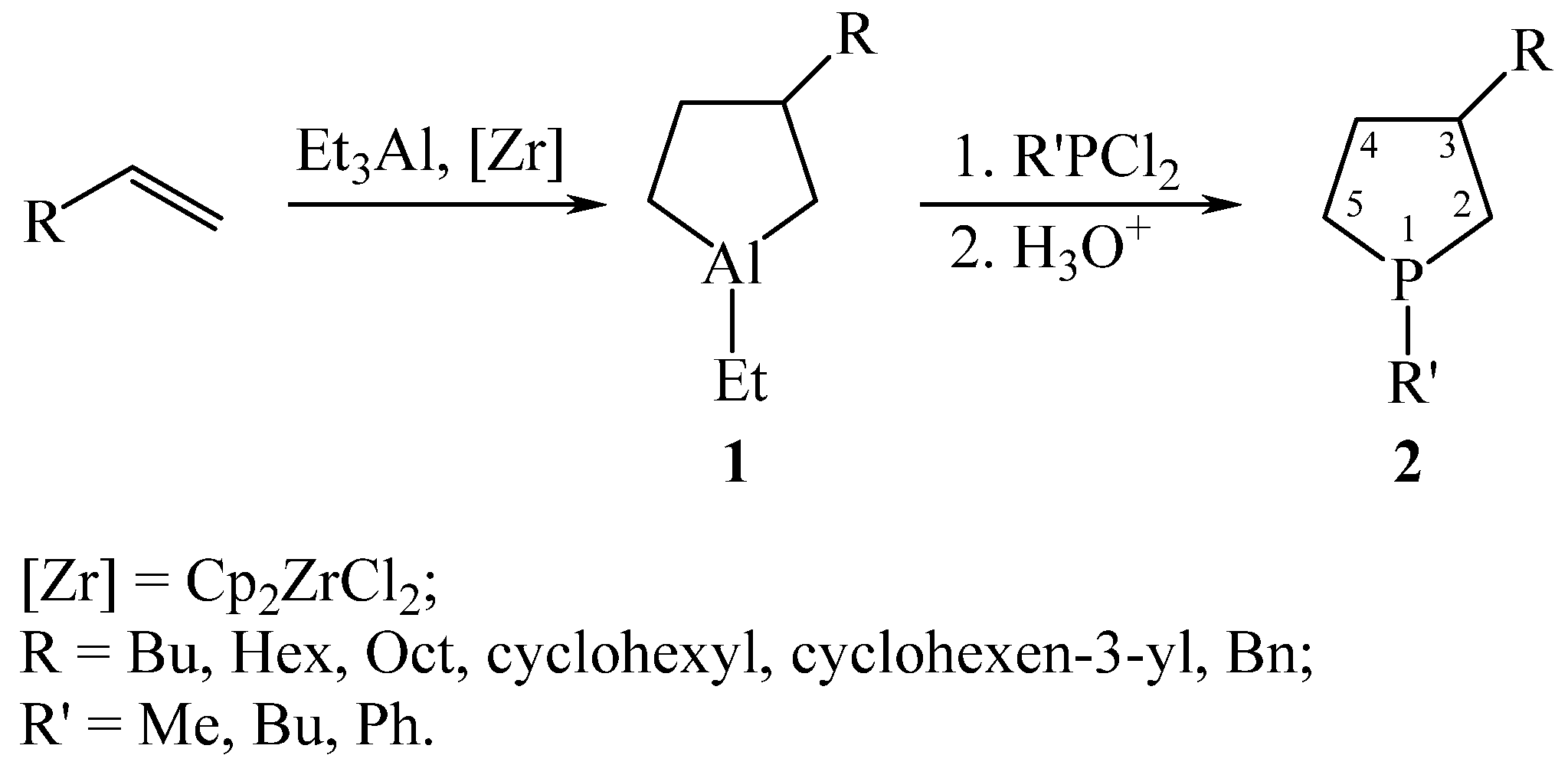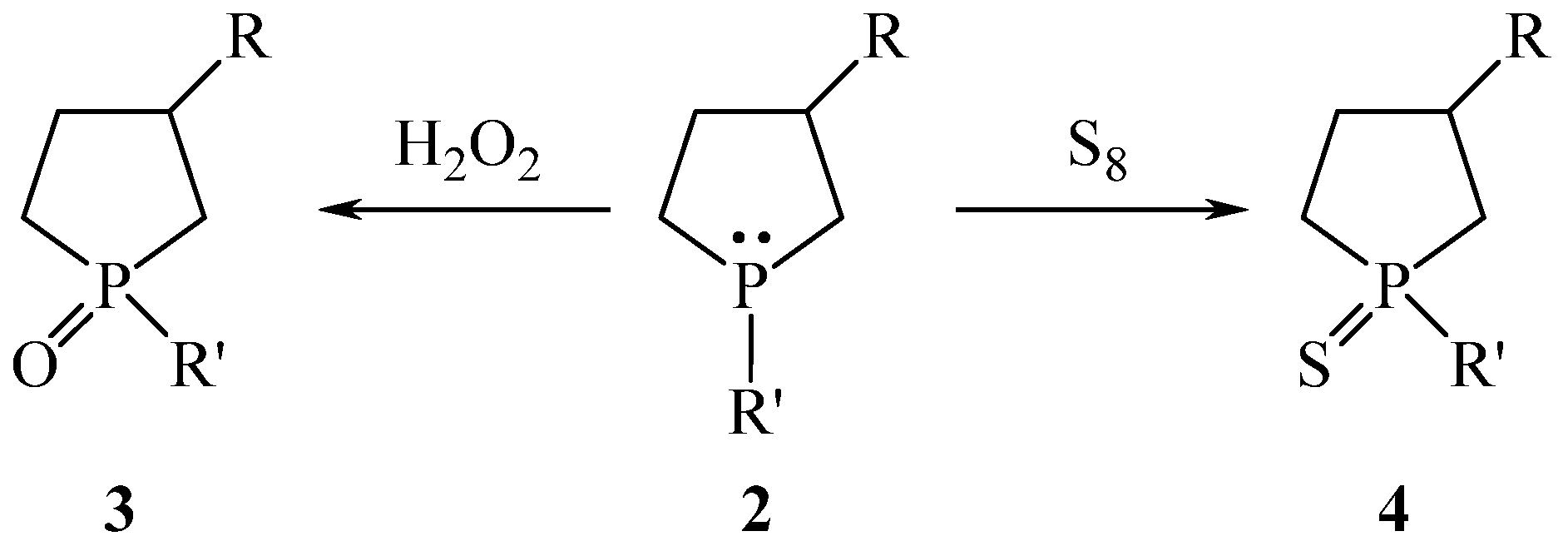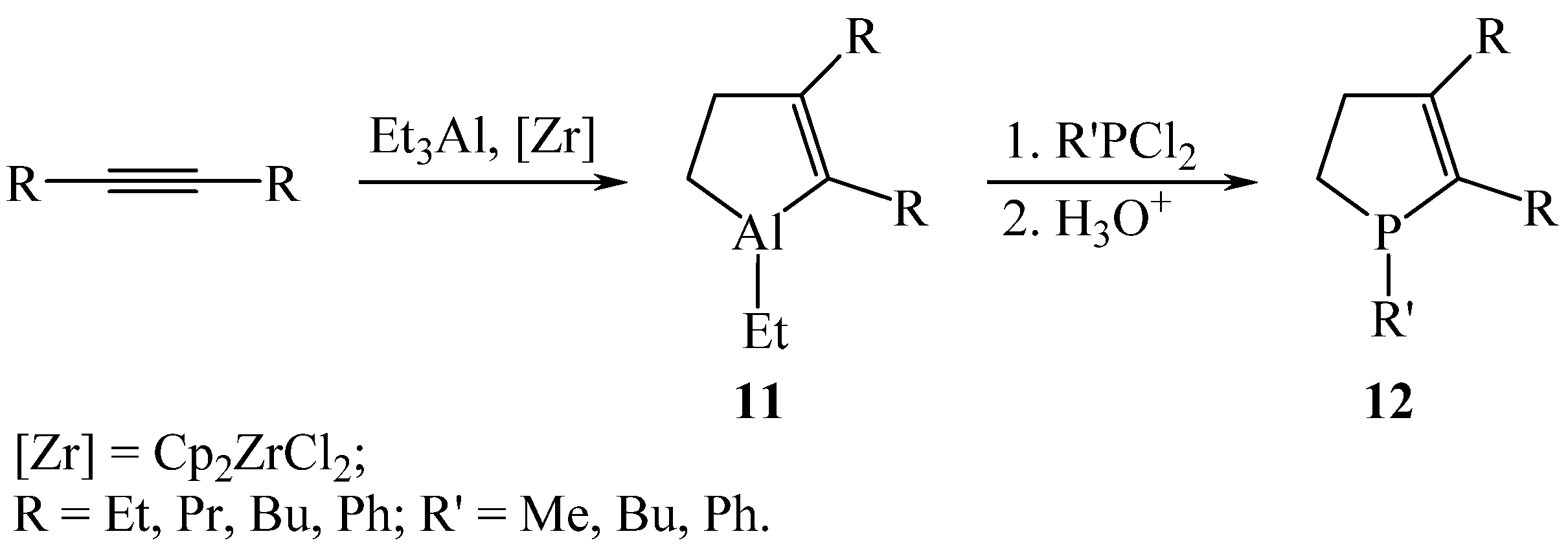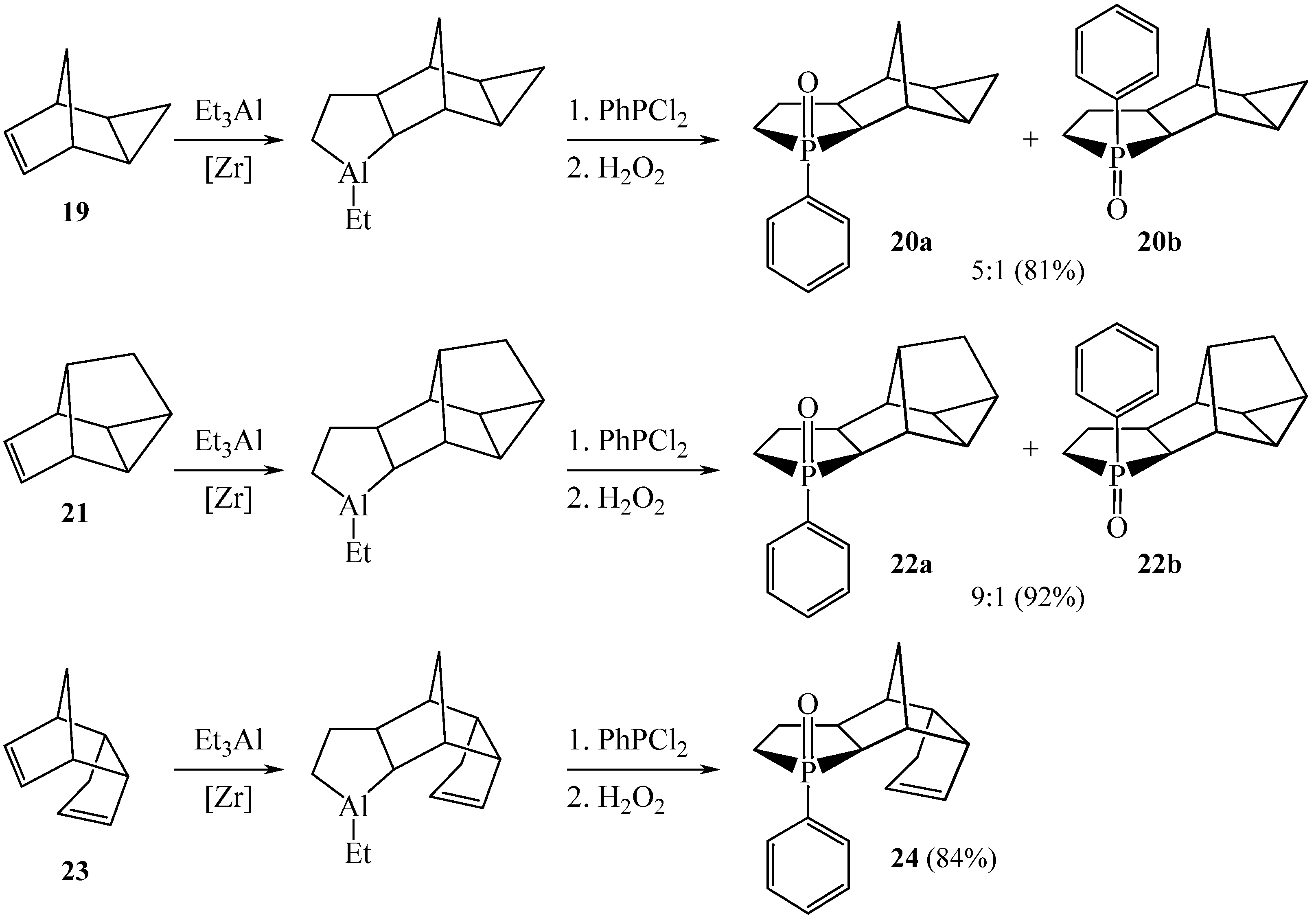Approach to the Synthesis of Five-Membered Organophosphorus Compounds via Alumoles and Alumolanes †
Abstract
:1. Introduction
2. Results and Discussion
3. Conclusions
Author Contributions
Funding
Institutional Review Board Statement
Informed Consent Statement
Data Availability Statement
Acknowledgments
Conflicts of Interest
References
- Keglevich, G.; Forintos, H.; Keseru, G.M.; Hegedus, L.; Toke, L. Synthesis of the spiro derivatives of 1,2-oxaphosphetes by [2 + 2] cycloaddition of cyclic 1-(2,4,6-triisopropylphenyl)phosphine oxides with dimethyl acetylenedicarboxylate. Tetrahedron 2000, 56, 4823–4828. [Google Scholar] [CrossRef]
- Yamashita, M.; Reddy, V.K.; Rao, L.N.; Haritha, B.; Maeda, M.; Suzuki, K.; Totsuka, H.; Takahashi, M.; Oshikawa, T. An efficient approach towards the stereospecific synthesis of epoxides from phospholene oxides. Tetrahedron Lett. 2003, 44, 2339–2341. [Google Scholar] [CrossRef]
- Kollar, L.P.; Keglevich, G. Heterocycles as ligands in homogeneous catalytic reactions. Chem. Rev. 2010, 110, 4257–4302. [Google Scholar] [CrossRef] [PubMed]
- Breit, B.; Fuchs, E. Phosphabarrelene–rhodium complexes as highly active catalysts for isomerization free hydroformylation of internal alkenes. Chem. Commun. 2004, 694–695. [Google Scholar] [CrossRef] [PubMed]
- Klosin, J.; Landis, C.R. Ligands for practical Rhodium-Catalyzed asymmetric hydroformylation. Acc. Chem. Res. 2007, 40, 1251–1259. [Google Scholar] [CrossRef] [PubMed]
- Yamada, M.; Yamashita, M.; Suyama, T.; Yamashita, J.; Asai, K.; Niimi, T.; Ozaki, N.; Fujie, M.; Maddali, K.; Nakamura, S.; et al. Preparation and characterization of novel 4-bromo-3,4-dimethyl-1-phenyl-2-phospholene 1-oxide and the analogous phosphorus heterocycles or phospha sugars. Bioorganic Med. Chem. Lett. 2010, 20, 5943–5946. [Google Scholar] [CrossRef] [PubMed]
- Fagan, P.J.; Nugent, W.A.; Calabrese, J.C. Metallacycle Transfer from Zirconium to Main Group Elements: A Versatile Synthesis of Heterocycles. J. Am. Chem. Soc. 1994, 116, 1880–1889. [Google Scholar] [CrossRef]
- Zhou, Y.; Yan, X.; Xi, C. Preparation of 2-phospholene derivatives from zirconacyclopentenes. Tetrahedron Lett. 2010, 51, 6136–6138. [Google Scholar] [CrossRef]
- Mirza-Aghayan, M.; Boukherroub, R.; Etemad-Moghadam, G.; Manuel, G.; Koenig, M. Zirconocyclisation: Access to New Racemic (di) Phosphines. Tetrahedron Lett. 1996, 37, 3109–3112. [Google Scholar] [CrossRef]
- Bousrez, G.; Jaroschik, F.; Martinez, A.; Harakat, D.; Nicolas, E.; Le Goff, X.F.; Szymoniak, J. Reactivity differences between 2,4- and 2,5-disubstituted zirconacyclopentadienes: A highly selective and general approach to 2,4-disubstituted phospholes. Dalton Trans. 2013, 42, 10997–11004. [Google Scholar] [CrossRef] [PubMed]
- Yan, X.; Xi, C. Conversion of Zirconacyclopentadienes into Metalloles: Fagan−Nugent Reaction and Beyond. Acc. Chem. Res. 2015, 48, 935–946. [Google Scholar] [CrossRef] [PubMed]
- Matano, Y.; Nakashima, M.; Imahori, H. A Convenient Method for the Synthesis of α-Ethynylphospholes and Modulation of Their p-Conjugated Systems. Angew. Chem. Int. Ed. 2009, 121, 4062–4065. [Google Scholar] [CrossRef]
- D’yakonov, V.A.; Makhamatkhanova, A.L.; Tyumkina, T.V.; Dzhemilev, U.M. Synthesis And Transformations Of Metallacycles 40. Catalytic Cycloalumination In The Synthesis Of 3-Substituted Phospholanes. Russ. Chem. Bull. 2012, 61, 1556–1559. [Google Scholar] [CrossRef]
- D’yakonov, V.A.; Makhamatkhanova, A.L.; Agliullina, R.A.; Dilmukhametova, L.K.; Tyumkina, T.V.; Dzhemilev, U.M. Aluminacyclopentanes in the synthesis of 3-substituted- and α,ω-bis-phospholanes. Beilshtein J. Org. Chem. 2016, 12, 406–412. [Google Scholar] [CrossRef] [PubMed]
- Potapov, V.M. Stereochemistry; Chemistry: Moscow, Russia, 1988. [Google Scholar]
- D’yakonov, V.A.; Makhamatkhanova, A.L.; Kalimullina, R.A.; Tyumkina, T.V.; Dzhemilev, U.M. Targeted synthesis of 2,3-disubstituted 2-phospholenes using catalytic cycloalumination of acetylenes. Tetrahedron Lett. 2014, 55, 3913–3915. [Google Scholar] [CrossRef]
- D’yakonov, V.A.; Makhamatkhanova, A.L.; Dilmukhametova, L.K.; Agliullina, R.A.; Tyumkina, T.V.; Dzhemilev, U.M. Catalytic Cycloalumination for the Synthesis of Norbornane-Annulated Phospholanes. Organometallics 2015, 34, 221–228. [Google Scholar] [CrossRef]








Disclaimer/Publisher’s Note: The statements, opinions and data contained in all publications are solely those of the individual author(s) and contributor(s) and not of MDPI and/or the editor(s). MDPI and/or the editor(s) disclaim responsibility for any injury to people or property resulting from any ideas, methods, instructions or products referred to in the content. |
© 2022 by the authors. Licensee MDPI, Basel, Switzerland. This article is an open access article distributed under the terms and conditions of the Creative Commons Attribution (CC BY) license (https://creativecommons.org/licenses/by/4.0/).
Share and Cite
Makhamatkhanova, A.L.; Tyumkina, T.V.; Dzhemilev, U.M. Approach to the Synthesis of Five-Membered Organophosphorus Compounds via Alumoles and Alumolanes. Chem. Proc. 2022, 12, 47. https://doi.org/10.3390/ecsoc-26-13637
Makhamatkhanova AL, Tyumkina TV, Dzhemilev UM. Approach to the Synthesis of Five-Membered Organophosphorus Compounds via Alumoles and Alumolanes. Chemistry Proceedings. 2022; 12(1):47. https://doi.org/10.3390/ecsoc-26-13637
Chicago/Turabian StyleMakhamatkhanova, Alevtina L., Tatyana V. Tyumkina, and Usein M. Dzhemilev. 2022. "Approach to the Synthesis of Five-Membered Organophosphorus Compounds via Alumoles and Alumolanes" Chemistry Proceedings 12, no. 1: 47. https://doi.org/10.3390/ecsoc-26-13637
APA StyleMakhamatkhanova, A. L., Tyumkina, T. V., & Dzhemilev, U. M. (2022). Approach to the Synthesis of Five-Membered Organophosphorus Compounds via Alumoles and Alumolanes. Chemistry Proceedings, 12(1), 47. https://doi.org/10.3390/ecsoc-26-13637





